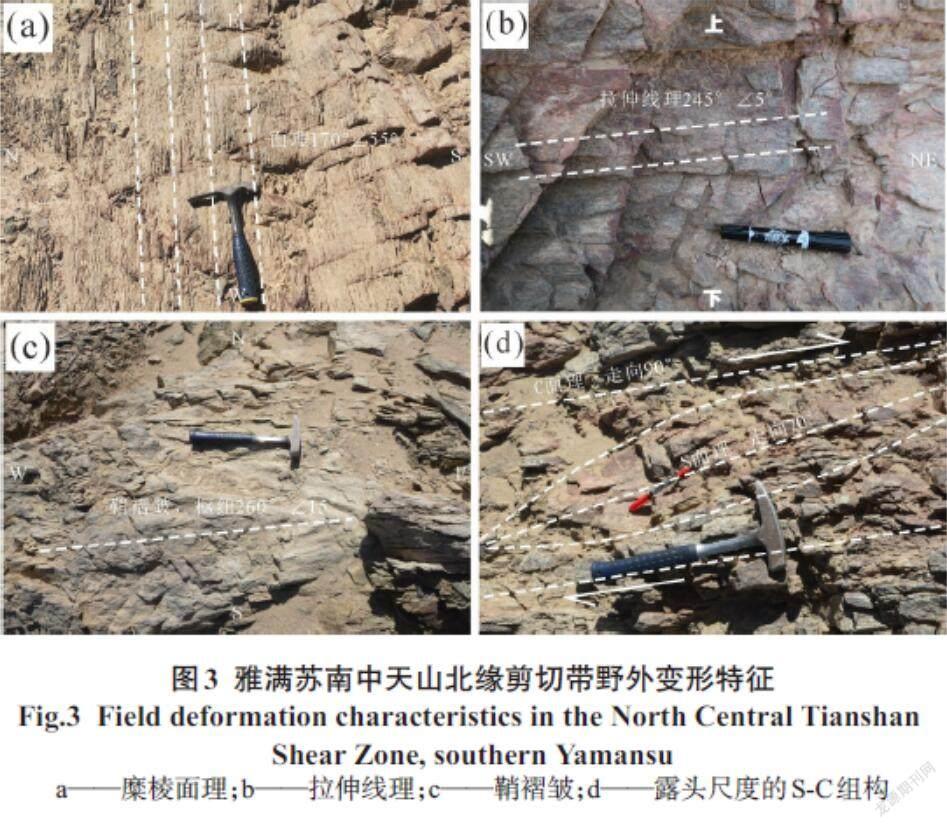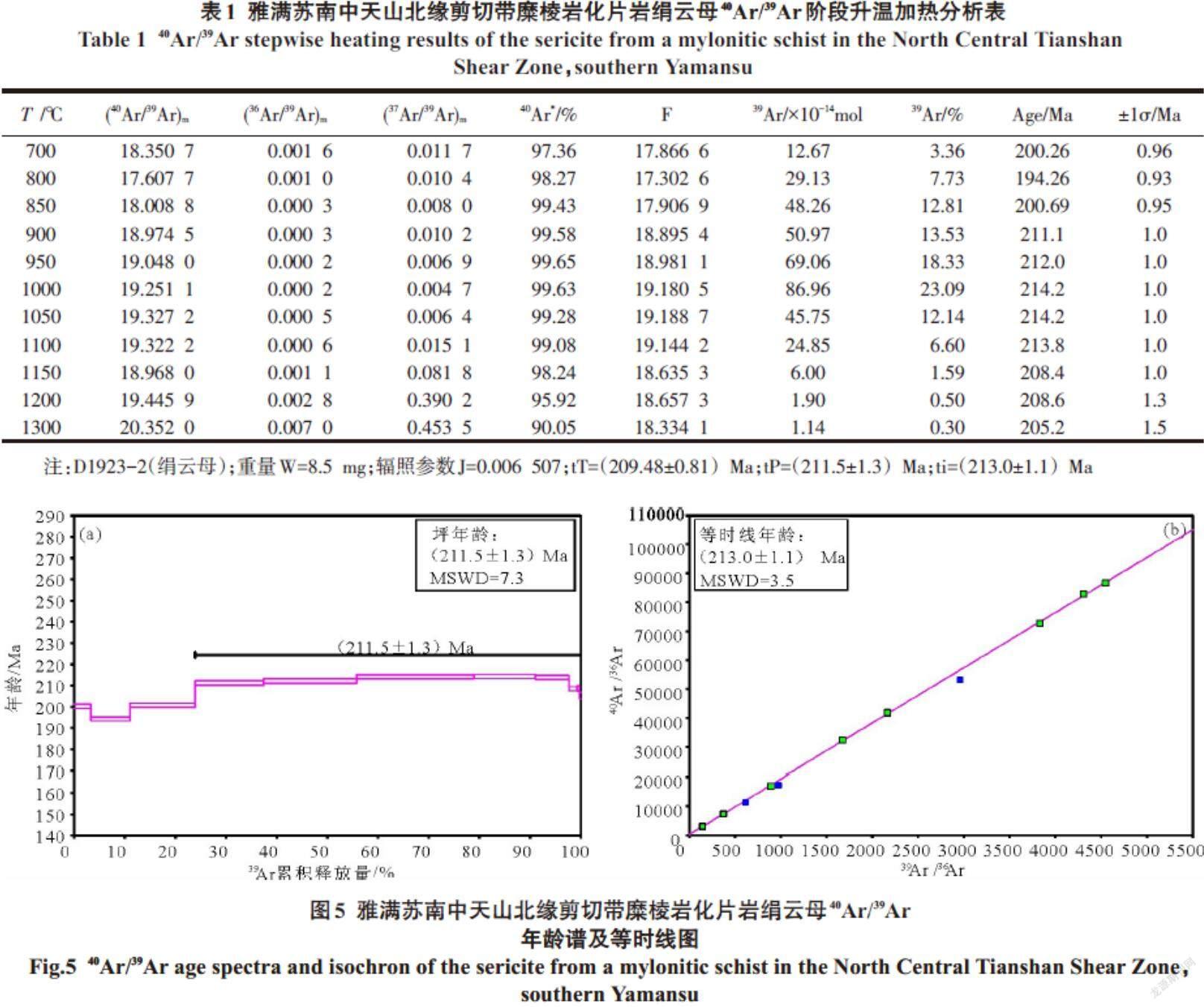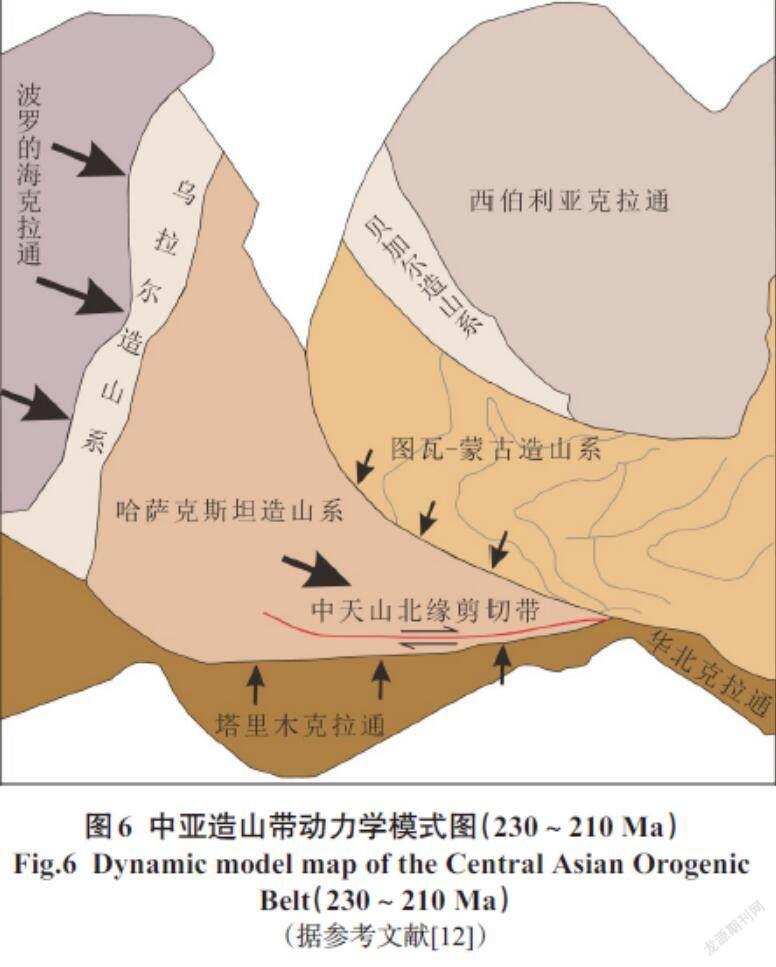中天山北缘剪切带东段晚三叠世右旋走滑:对中亚造山带西南缘造山复活的响应
2022-04-23刘博,陈正乐,袁峰,张青,韩凤彬,张文高,霍海龙,李季霖,赵同阳,韩琼,李平,夏冬,屈梦梦
刘博,陈正乐,袁峰,张青,韩凤彬,张文高,霍海龙,李季霖,赵同阳,韩琼,李平,夏冬,屈梦梦






摘 要:中天山北缘剪切带东段位于东天山地区,是重塑中亚造山带西南缘演化过程的关键断裂之一。在雅满苏南,中天山北缘剪切带东段韧性变形强烈。野外观测和镜下观察表明,剪切带具有典型的右旋走滑特征。糜棱岩化片岩的绢云母40Ar/39Ar坪年龄为(211.5±1.3) Ma,说明该变形事件发生在晚三叠世。进一步综合区域资料分析认为,中天山北缘剪切带东段晚三叠世的韧性走滑是对中亚造山带西南缘聚合后再次复活造山的响应;中亚造山带西南缘晚三叠世复活造山时限为230~210 Ma,其动力主要来自于NWW方向的波罗的海克拉通的挤压。
关键词:中天山北缘剪切带;中亚造山带西南缘;40Ar/39Ar定年;晚三叠世;右旋走滑
中亚造山带是世界上最典型的增生型造山带之一,由古亚洲洋长期俯冲-碰撞而聚合形成[1],在其聚合完成后,造山作用并没有彻底终止,之后又经历了多期的造山复活。在造山带复活过程中,剪切带往往扮演着异常活跃的角色,例如秦岭构造带受新生代以来印度-欧亚大陆碰撞影响而造山复活,其南部边界青川剪切带同时以强烈走滑的方式响应[2]。在中亚造山带西南缘,剪切带极为发育,多条大规模剪切带因后期隆升剥蚀而出露良好,为研究中亚造山带西南缘的造山复活过程提供了一个窗口。在中亚造山带西南缘的东天山地区,中天山北缘剪切带东段(阿其克库都克断裂)出露较好,其完整地经历了中亚造山带西南缘造山过程中复杂的多期变形作用[3-12],其活动历史是东天山地区乃至中亚造山带西南缘的演化过程的缩影,对其研究意义重大。但目前为止,学者们多关注其在俯冲-碰撞过程中的活动,对其在后期复活造山中的活动过程和时限却缺乏研究。
本文对雅满苏南中天山北缘剪切带东段进行了研究,通过详细的野外观测,结合室内微观构造分析,明确了其几何学、运动学特征,同时通过绢云母40Ar/39Ar年龄测定,制约了该剪切带复活时限,并进一步结合中亚造山带西南缘该时期整体复活造山运动特征,探讨该剪切带复活的动力学背景,为今后研究工作提供了新的视角。
1 区域地质概况
中亚造山带位于波罗的海(东欧)克拉通以东、西伯利亚克拉通以南、塔里木克拉通和华北克拉通以北,呈EW向从里海延伸至西太平洋北部,横跨俄罗斯、哈萨克斯坦、吉尔吉斯斯坦、乌兹别克斯坦、塔吉克斯坦、蒙古和中国北部(图1-a)[1,13-19]。中亚造山带由不同的构造单元(包括岛弧、弧相关盆地、蛇绿岩、增生楔、海山、大洋高原及微大陆等)聚合形成[1,20,21]。 宽约300 km的东天山位于北部的吐鲁番-哈密盆地和南部的塔里木克拉通之间,在中亚造山带西南缘占据重要位置,东天山由北向南主要由觉罗塔格构造带、中天山地块和南天山造山带组成(图1-b)[22-30]。
中天山北缘剪切带为一条大型岩石圈断裂[31],该剪切带在东天山走向近EW向,延伸1 000 km以上,分隔了北侧觉罗塔格构造带晚古生代火山-沉积建造与南侧中天山前寒武系变质岩系[3-4,25,32-35]。剪切带主要由绿片岩化和糜棱岩化的早古生代杂砂岩、中—新元古代片岩、石英片岩、片麻岩及花岗质片麻岩组成[3-4],并发育有古生代高压变质岩和蛇绿岩[36-37]。
2 野外描述与样品采集
雅满苏南出露中新统桃树园组、中元古界星星峡群,区域上侵入岩有二长花岗岩。中天山北缘韧性剪切带沿中天山地块北部边缘展布,宽500~1 000 m,韧性变形组构发育在中元古界星星峡群糜棱岩化片岩中(图2-a)。在研究区进行了详细的糜棱面理和拉伸线理的测量与统计,并将糜棱面理的法线和拉伸线理进行了等面积、下半球赤平投影(图2-b),糜棱面理产状稳定,倾向SSE向,主体产状为155°~180°∠55°~85°(图3-a),拉伸线理近水平,大部分向SWW倾伏,主体产状为235°~270°∠5°~25°,少数向NEE倾伏,主体产状为79°~90°∠5°~10°(图3-b)。剪切带内发育有典型的鞘褶皱,枢纽产状260°∠15°(图3-c)。枢纽近水平的鞘褶皱和区域上近水平的拉伸线理均暗示该剪切带为走滑剪切带。糜棱岩化片岩中露头尺度发育典型的S-C组构,形成S面理与剪切带C面理两种面理,其S面理与C面理夹角明确指示右旋剪切(图3-d)。
对糜棱岩化片岩样品的薄片在镜下进行了观察,显微构造现象也十分丰富:大量刚性石英或长石颗粒作为“”型旋转碎斑系,细小的石英和云母类矿物组成拖尾,其拖尾明确指示右旋剪切(图4-a,b);斜长石、石英、云母类矿物组成矿物集合体,拉伸方向沿S面理展布,与剪切带C面理组成S-C组构,指示右旋剪切(图4-c);细小的石英组成的S面理,与绢云母组成的C面理共同构成S-C组构,指示右旋剪切(图4-d)。这些野外和镜下特征表明,雅满苏南中天山北缘剪切带具明显的右旋走滑特征。
3 变形年代学
3.1 测试方法
在河北廊坊市地科技术服务有限公司对糜棱岩化片岩样品D1923-2(采样位置见图2)进行测年单矿物绢云母的挑选,绢云母无污染,无氧化,纯度大于99%,达到测试的要求。
绢云母的40Ar/39Ar测试在核工业北京地质研究院分析测试研究中心完成,具体步骤如下:①配置浓度为5%的稀硝酸浸泡样品,经过去离子水、丙酮分别超声清洗15 min后,将样品放置烘箱内60℃干燥;②将样品用铝箔包好放置石英管内,同时将标准物质黑云母ZBH-25放置石英管不同位置用于计算中子通量梯度,然后将石英管真空熔封,放置铝制栅格内,铝制栅格裹上Cd皮,焊接在5052型合金铝罐内,送至反应堆辐照孔道内进行辐照;③照射过的样品冷却至安全放射剂量返回实验室,采用雙真空钽片加热炉阶段升温法释放样品中气体,气体依次经过液氮U型冷阱,两组锆-铝吸气剂泵(温度分别为450℃、室温)对气体进行纯化,最后仅留惰性气体进入稀有气体质谱仪Argus VI进行Ar同位素组成测试,测试全流程均为自动化控制;④通过辐照纯净的CaF2 和K2SO4,对样品的Ca和K在辐照过程中产生的干扰进行校正,通过全熔石英管内黑云母ZBH-25获得石英管内的中子通量梯度,计算获得不同位置样品的辐照常数(J值),通过测试大气中的氩同位素组成获得质谱的质量歧视校正因子,衰变常数则采用推荐值5.543×10-10[40];⑤采用CALC 2.40软件进行数据处理,获得样品年龄谱图。
3.2 测试结果
D1923-2样品40Ar/39Ar阶段升温年龄分析结果见表1。绢云母经历了11个阶段的分步加热,加热温度区间为700℃~1 300℃,总气体年龄(tT)为(209.48±0.81) Ma。900℃~1 300℃的8个温度阶段组成了一个年龄坪,坪年龄(tp)为(211.5±1.3) Ma(MSWD=7.3),对应了76.08%的39Ar释放量(图5-a),相应的39Ar/36Ar-40Ar/36Ar等时线年龄(ti)为(213.0±1.1) Ma,(MSWD=3.5)(图5-b),反等时线年龄为(212.9±1.1) Ma(MSWD=3.5)。在该数据中,坪年龄包括了3个以上的连续温度阶段,对应超过了50%的39Ar释放量,且坪年龄、等时线年龄和反等时线年龄在误差范围内一致,数据整体质量较好,可制约中天山北缘剪切带东段右旋走滑活动的时限。
4 讨论
4.1 活动时限探讨
一般认为,中亚造山带西南缘的增生造山作用终止于约240 Ma[38],但增生造山作用的终止并不是造山运动的终结,后期往往有幕式的造山复活事件。最新的研究表明,在东天山地区,磷灰石裂变径迹揭示了在230~210 Ma期间存在快速隆升剥蚀[41],且本文得到的绢云母40Ar/39Ar年龄暗示了中天山北缘剪切带东段在212 Ma再次以右旋走滑的形式复活,这些证据表明东天山乃至中亚造山带西南缘在晚三叠世可能存在一期区域性的造山复活事件。造山带的再次复活不仅会造成先存剪切带的再次活动,也往往伴随着逆冲推覆和大规模的隆升剥蚀。从目前的研究成果来看,该期构造事件在整个中亚造山带西南缘都有较好体现,本次对该期构造事件的时限进行了整理:①在准噶尔盆地西北缘,详细的地震资料表明,红山嘴-车排子、克拉玛依-百口泉、乌尔禾-夏子街断裂等盆地边缘断裂系统在晚三叠世重新活化,发生了右旋扭压运动,随后倾斜的侏罗系覆盖了变形的二叠—三叠系,形成了区域不整合[42];②在准噶尔盆地内部,乌伦古坳陷的上三叠统整体沉积厚度较稳定,朝着陆梁隆起方向有轻微的减薄,这种生长地层指示了陆梁隆起从晚三叠世开始在挤压作用下隆升[43] ;③在准噶尔盆地南缘,地震资料显示柴窝堡凹陷的三葛庄次凸晚三叠世又遭受了强烈的挤压运动,在三葛庄次凸表现为三叠系与侏罗系之间的角度不整合[44] ;④在博格达地区,地震反射特征表明,下侏罗统八道湾组地层明显超覆于下伏上三叠统郝家沟组地层之上,表明晚三叠世存在大规模的挤压隆升[45] ;⑤在准噶尔盆地西南缘,自晚三叠世开始发育的四棵树山前坳陷属独立的小型走滑盆地,与当时中天山北缘大型剪切带在挤压同时兼具一定的走滑活动有关[46] ;⑥在准噶尔-阿拉套地区,磷灰石裂变径迹记录了230~210 Ma的快速隆升剥蚀[47],这与在东天山记录的隆升剥蚀时限完全一致 [41]。
综上所述,诸多证据表明该期复活造山运动发生在晚三叠世,具体时限约为230~210 Ma。
4.2 构造背景探讨
前文已述,230~210 Ma这期复活造山运动在中亚造山带西南缘均有体现,但其动力学背景需进一步探讨。Xiao Wenjiao et al.和Yi Zhiyu et al.对中亚造山带西南缘的古板块格局进行了重建[19,48],结果表明,中亚造山带西南缘自晚石炭世开始处于西伯利亚、塔里木和波罗的海3个刚性克拉通的挤压中心,主要受到近NS向和NWW向的挤压作用。这种挤压作用自中亚造山带西南缘开始聚合以来,是表现为多期的、幕式的,在不同时期所受到的挤压应力方向略有不同,挤压应力强度则处于波动状态,使中亚造山带西南缘构造演化呈现出明显的阶段性。
中亚造山带西南缘晚三叠世的构造运动过程表明,中亚造山带西南缘在230~210 Ma,仍然受到NS向和NWW向挤压应力作用,但这种挤压应力可能更多地来自于NWW向的波罗的海克拉通,证据如下:
(1) 乌拉尔造山系是波罗的海克拉通与中亚造山带西南缘的结合带,在乌拉尔造山系中,断层系统的Rb-Sr同位素测年表明,与断层相关糜棱岩的发育年龄分为247~240 Ma和229 Ma两个阶段[49],说明至少在约247 Ma,波罗的海克拉通和中亚造山带西南缘的哈萨克斯坦造山系已经发生碰撞,NNE向的乌拉尔造山系将它们缝合在一起[50],在240 Ma的中亚造山带西南缘的增生造山作用暂时中止,这已得到了大量年代学数据的证实[38]。229 Ma的糜棱岩发育说明乌拉尔造山带又再度活化,中亚造山带西南缘再次受到来自波罗的海克拉通NWW向应力的强挤压,这与本文所认为的约230~210 Ma的这期构造运动开始时限相吻合。
(2) 在晚三叠世,西准噶尔地区持续向准噶尔盆地内部挤压冲断,构造变形主要集中在车排子凸起南侧,逆冲断层平面上呈NNE向[51],说明该时期挤压应力可能来自NWW向的波罗的海克拉通。
(3) 在准噶尔盆地南缘的柴窝堡凹陷,其内部在晚三叠世再次活化的逆冲断裂呈NNE向[44],暗示该时期挤压应力来源于NWW向。
(4) 在准噶尔盆地的内部东缘,晚三叠世明显受到来自NWW向应力的强挤压。该地区的东南部在挤压应力作用下处于抬升剥蚀状态,同时该地区的西北部开始活动,形成了NNE向展布的帳北断褶带的雏形[46]。
综上,中亚造山带西南缘在230~210 Ma的动力学模式得以还原(图6)。中亚造山带西南缘在该阶段处于西伯利亚、波罗的海和塔里木克拉通的挤压作用下,但来自NWW向波罗的海克拉通的挤压应力占主导作用。在这种强挤压背景下,中亚造山带西南缘以断裂走滑、逆冲或区域上的隆升剥蚀等多种方式响应。中天山北缘剪切带东段走向为近EW向或NEE向,与来自于NWW向的挤压应力存在一定交角,挤压应力在靠近剪切带时会分解成垂直剪切带的挤压分量和平行剪切带的走滑分量,使中天山北缘剪切带东段再次以右旋走滑形式复活。
5 结论
(1) 对雅满苏南中天山北缘剪切带东段的运动学研究表明,该剪切带具明显右旋走滑的特征。糜棱岩化片岩绢云母40Ar/39Ar坪年龄为(211.5±1.3) Ma,说明该期变形事件发生在晚三叠世。
(2) 中天山北缘剪切带东段晚三疊世的右旋走滑是对中亚造山带西南缘增生造山结束后再次复活造山的响应,中亚造山带西南缘的复活造山时限为230~210 Ma,其动力来自于NWW向的波罗的海克拉通的挤压。
致谢:十分感谢审稿人和编辑部对本文提出的诸多宝贵意见和建议,对提高本文质量起到很大作用,在此一并表示衷心感谢!
参考文献
[1] Windley B F , Alexeiev D , Xiao W , et al. Tectonic models for accretion of the Central Asian Orogenic Belt[J]. Journal of the Geological Society, 2007, 164(1):31-47.
[2] 李建,张岳桥,熊金红,等.秦岭南缘青川断裂新生代变形特征及其走滑运动学转换[J].大地构造与成矿学,2016,40(3):405-418.
[3] 舒良树, 夏飞雅克, 马瑞士. 中天山北缘大型右旋走滑韧剪带研 究[J]. 新疆地质, 1998(04):326-336.
[4] 舒良树, 夏飞雅克, 郭令智,等. 新疆中天山北缘阿齐克库都格—尾亚古生代大型韧性剪切带研究[J]. 地质学报, 1999, 2:95-95.
[5] Shu L S, Charvet J, Lu H, et al. Paleozoic accretion-collision events and kinematics of ductile deformation in the eastern part of the southern-central Tianshan Belt, China[J]. Acta Geologica Sinica, 2002, 76(3): 308-323.
[6] Laurent-Charvet S, Charvet J, Monié P, et al. Late Paleozoic strike-slip shear zones in eastern Central Asia (NW China): New structural and geochronological data[J].Tectonics, 2003,22(2) :1-24.
[7] De Jong K, Wang B, Faure M, et al. New 40 Ar/39 Ar age constraints on the Late Palaeozoic tectonic evolution of the western Tianshan (Xinjiang, northwestern China), with emphasis on Permian fluid ingress[J]. International Journal of Earth Sciences, 2009, 98(6): 1239-1258.
[8] Yang T N , Li J Y , Wang Y , et al. Late Early Permian (266Ma) N-S compressional deformation of the Turfan basin, NW China: the cause of the change in basin pattern[J]. International Journal of Earth Sciences, 2009, 98(6):1311-1324.
[9] 许志琴, 李思田, 张建新,等. 塔里木地块与古亚洲/特提斯构造体系的对接[J]. 岩石学报, 2010, 27(1):1-22.
[10] Zhu Y. Zircon U-Pb and muscovite 40Ar/39Ar geochronology of the gold-bearing Tianger mylonitized granite, Xinjiang, northwest China: Implications for radiometric dating of mylonitized magmatic rocks[J]. Ore Geology Reviews, 2011, 40(1): 108-121.
[11] 蔡志慧, 许志琴, 何碧竹,等. 东天山-北山造山带中大型韧性剪切带属性及形成演化时限与过程[J]. 岩石学报, 2012, 28(6):1875-1895.
[12] 王凯, 计文化, 孟勇,等. 天山造山带东段构造变形对增生造山末期的响应[J]. 大地构造与成矿学, 2019, 43(5):894-910.
[13] Jahn B, Wu F, Chen B. Granitoids of the Central Asian Orogenic Belt and continental growth in the Phanerozoic[J]. Earth and Environmental Science Transactions of the Royal Society of Edinburgh, 2000, 91(1-2): 181-193.
[14] Khain E V, Bibikova E V, Salnikova E B, et al. The Palaeo-Asian ocean in the Neoproterozoic and early Palaeozoic: new geochronologic data and palaeotectonic reconstructions[J]. Precambrian Research, 2003, 122(1-4): 329-358.
[15] Jahn B. The Central Asian Orogenic Belt and growth of the continental crust in the Phanerozoic[J]. Geological Society, London, Special Publications, 2004, 226(1): 73-100.
[16] Sun M, Yuan C, Xiao W, et al. Zircon U-Pb and Hf isotopic study of gneissic rocks from the Chinese Altai: progressive accretionary history in the early to middle Palaeozoic[J]. Chemical Geology, 2008, 247(3-4): 352-383.
[17] Schulmann K, Paterson S. Asian continental growth[J]. Nature Geoscience, 2011, 4(12): 827-829.
[18] Kröner A, Kovach V, Belousova E, et al. Reassessment of continental growth during the accretionary history of the Central Asian Orogenic Belt[J]. Gondwana Research, 2014, 25(1): 103-125.
[19] Xiao W, Windley B F, Sun S, et al. A tale of amalgamation of three Permo-Triassic collage systems in Central Asia: oroclines, sutures, and terminal accretion[J]. Annual review of earth and planetary sciences, 2015, 43: 477-507.
[20] Wilhem C, Windley B F, Stampfli G M. The Altaids of Central Asia: a tectonic and evolutionary innovative review[J]. Earth-Science Reviews, 2012, 113(3-4): 303-341.
[21] Zhou J B, Wilde S A, Zhao G C, et al. Nature and assembly of microcontinental blocks within the Paleo-Asian Ocean[J]. Earth-Science Reviews, 2018, 186: 76-93.
[22] Coleman R G. Continental growth of northwest China[J]. Tectonics, 1989, 8(3): 621-635.
[23] Allen M B, Windley B F, Zhang C. Palaeozoic collisional tectonics and magmatism of the Chinese Tien Shan, central Asia[J]. Tectonophysics, 1993, 220(1-4): 89-115.
[24] Allen M B, Windley B F, Zhang C, et al. Evolution of the Turfan basin, Chinese central Asia[J]. Tectonics, 1993, 12(4): 889-896.
[25] Xiao W J, Zhang L C, Qin K Z, et al. Paleozoic accretionary and collisional tectonics of the Eastern Tianshan (China): implications for the continental growth of central Asia[J]. American Journal of Science, 2004, 304(4): 370-395.
[26] Xiao W, Windley B F, Allen M B, et al. Paleozoic multiple accretionary and collisional tectonics of the Chinese Tianshan orogenic collage[J]. Gondwana Research, 2013, 23(4): 1316-1341.
[27] Charvet J, Shu L S, Laurent-Charvet S, et al. Palaeozoic tectonic evolution of the Tianshan belt, NW China[J]. Science China Earth Sciences, 2011, 54(2): 166-184.
[28] Chen X, Shu L, Santosh M, et al. Island arc-type bimodal magmatism in the eastern Tianshan Belt, Northwest China: geochemistry, zircon U-Pb geochronology and implications for the Paleozoic crustal evolution in Central Asia[J]. Lithos, 2013, 168: 48-66.
[29] Zhang X, Zhao G, Sun M, et al. Tectonic evolution from subduction to arc-continent collision of the Junggar ocean: Constraints from U-Pb dating and Hf isotopes of detrital zircons from the North Tianshan belt, NW China[J]. Bulletin, 2016, 128(3-4): 644-660.
[30] Zhang X, Zhao G, Eizenhöfer P R, et al. Tectonic transition from Late Carboniferous subduction to Early Permian post-collisional extension in the Eastern Tianshan, NW China: Insights from geochronology and geochemistry of mafic-intermediate intrusions[J]. Lithos, 2016, 256: 269-281.
[31] 舍建忠, 朱志新, 賈健,等. 新疆主要断裂的分布及其特征[J]. 新疆地质, 2020, 38(1):9-20.
[32] Windley B F, Allen M B, Zhang C, et al. Paleozoic accretion and Cenozoic redeformation of the Chinese Tien Shan range, central Asia[J]. Geology, 1990, 18(2): 128-131.
[33] 马瑞士, 舒良树, 孙家齐.东天山构造演化与成矿[M].北京:地质出版社,1997.
[34] Xiao W, Han C, Yuan C, et al. Middle Cambrian to Permian subduction-related accretionary orogenesis of Northern Xinjiang, NW China: implications for the tectonic evolution of central Asia[J]. Journal of Asian Earth Sciences, 2008, 32(2-4): 102-117.
[35] 木合塔尔·扎日, 张晓帆, 吴兆宁,等. 东天山准噶尔—哈萨克斯 坦板块与塔里木板块缝合线的再厘定及其意义[J]. 地学前缘, 2009, 016(3):138-148.
[36] 舒良树,卢华复,印栋豪,等.中、南天山古生代增生-碰撞事件和变形运动学研究[J].南京大学学报(自然科学版),2003,(1):17-30.
[37] 陈希节,舒良树,马绪宣.新疆尾亚蛇绿混杂岩与镁铁质麻粒岩地球化学特征及构造意义[J].高校地质学报,2012,18(4):661-675.
[38] Han Y, Zhao G. Final amalgamation of the Tianshan and Junggar orogenic collage in the southwestern Central Asian Orogenic Belt: Constraints on the closure of the Paleo-Asian Ocean[J]. Earth-Science Reviews, 2018, 186: 129-152.
[39] Zhang X, Zhao G, Sun M, et al. Tectonic evolution from subduc tion to arc-continent collision of the Junggar ocean:Constraints from U-Pb dating and Hf isotopes of detrital zircons from the North Tianshan belt, NW China[J]. Bulletin, 2016, 128(3-4): 644- 660.
[40] Steiger R H, Jäger E. Subcommission on geochronology: convention on the use of decay constants in geo-and cosmochronology[J]. Earth and planetary science letters, 1977, 36(3): 359-362.
[41] Gong L, Kohn B P, Zhang Z, et al. Exhumation and preservation of Paleozoic porphyry Cu deposits: Insights from the Yandong deposit, southern Central Asian orogenic belt[J]. Economic Geology, 2021, 116(3): 607-628.
[42] Liang Y, Zhang Y, Chen S, et al. Controls of a strike-slip fault system on the tectonic inversion of the Mahu depression at the northwestern margin of the Junggar Basin, NW China[J]. Journal of Asian Earth Sciences, 2020, 198: 104229.
[43] 文磊, 孫相灿, 李程,等. 准噶尔盆地乌伦古坳陷中-新生代构造演化及成因机制[J]. 岩石学报, 2019, 35(4):1107-1120.
[44] 梁鑫鑫,陈石,陈书平,等.博格达山西缘三葛庄凸起多期构造变形及其对博格达山隆升的响应[J].科学技术与工程,2020,20 (28):11455-11462.
[45] 王新桐.博格达山周缘二叠—侏罗系地层格架及沉积演化[D].中国石油大学(华东),2017.
[46] 卢苗安.天山东段盆山构造格局的多期演变[D].中国地震局地质研究所,2007.
[47] Glorie S, Otasevic A, Gillespie J, et al. Thermo-tectonic history of the Junggar Alatau within the Central Asian Orogenic Belt (SE Kazakhstan, NW China): Insights from integrated apatite U/Pb, fission track and (U-Th)/He thermochronology[J]. Geoscience Frontiers, 2019, 10(6): 2153-2166.
[48] Yi Z, Huang B, Xiao W, et al. Paleomagnetic study of Late Paleozoic rocks in the Tacheng Basin of West Junggar (NW China): Implications for the tectonic evolution of the western Altaids[J]. Gondwana Research, 2015, 27(2): 862-877.
[49] Hetzel R, Glodny J. A crustal-scale, orogen-parallel strike-slip fault in the Middle Urals: age, magnitude of displacement, and geodynamic significance[J]. International Journal of Earth Sciences, 2002, 91(2): 231-245.
[50] Pease V. Eastern Europe: The Timanian and Urailian Orogens[M]. Department of Geological Sciences, Stockholm University, Stockholm, Sweden, 2020, 302-310.
[51] 梁宇生. 准噶尔盆地西部车排子凸起的地质结构及形成演化[D].中国地质大学(北京),2019.
Late Triassic Dextral Strike-Slip Deformation in the Eastern Segment of the North Central Tianshan Shear Zone: Response to an Orogenic Revival Event in the Southwestern Margin of the
Central Asian Orogenic Belt
Liu Bo1,2,Cheng Zhengle1,3,Yuan Feng2,Zhang Qing1,Han Fengbin1,Zhang Wengao1,Huo Hailong1,Li Jilin1,2,Zhao Tongyang4,Han Qiong4,Li Ping4,Xia Dong4,Qu Mengmeng3
(1.Key Laboratory of Paleomagnetism and Tectonic Reconstruction of Ministry of Land and Resources,
Institute of Geomechanics, Chinese Academy of Geological Sciences, Beijing,100081, China;2.School of Resources and Environmental Engineering, Hefei University of Technology, Hefei, , Anhui 230009, China;3.State Key Laboratory of nuclear resources and environment, East China University of Technology, Nanchang , Jiangxi ,330013, China;
4.Xinjiang Institute of Geological Survey, Urumqi,Xinjiang,830000, China)
Abstract: The eastern segment of the North Central Tianshan Shear Zone, located in the Eastern Tianshan area, is one of the key faults to understand the evolution processes of the southwestern margin of the Central Asian Orogenic Belt. In southern Yamansu, the eastern part of the shear zone in the northern margin of the Middle Tianshan Mountains has strong ductile deformation. Field and microscopic observations show that the shear zone is characterized by dextral strike-slip deformation. The 40Ar/39Ar dating of sericite from a mylonitic schist yields an age of 211.5 ± 1.3Ma, indicating that the deformation event occurred in the Late Triassic. Further analyses of regional data suggest that the Late Triassic strike-slip in this shear zone should be a response to an orogenic revival event in the southwestern margin of the Central Asian Orogenic Belt.The Late Triassic revival orogeny time in the southwest margin of the Central Asian Orogenic Belt is 230 ~ 210 Ma.Its driving force mainly comes from the compression of the Baltic craton in the NWW direction.
Key words: 40Ar/39Ar dating; late Triassic; dextral strike-slip; Shear Zone in northern margin of Central Tianshan; The southwestern margin of the Central Asian Orogenic Belt
